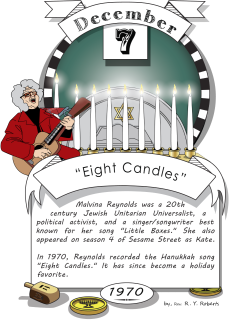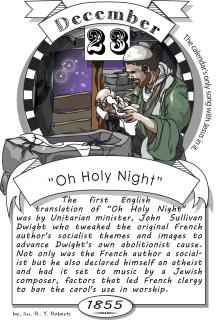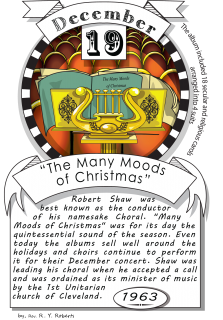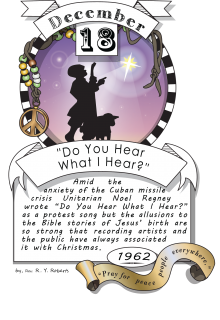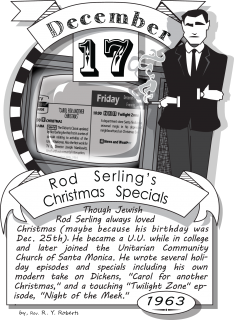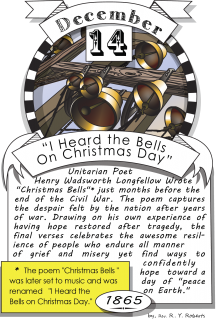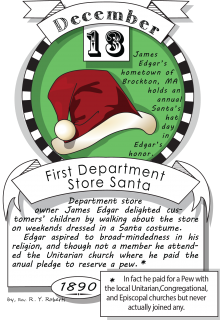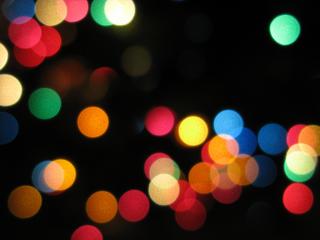
Christmas Eve is December 24, and is frequently celebrated in an evening service. It often includes “lessons and carols” and sometimes a story that conveys the spirit of Christmas. Some Unitarian Universalist congregations include a candle-lighting ritual in the service, in which the church lights are dimmed and people pass a flame from candle to candle until everyone is holding a lit candle.
Unlike many Christian faiths, Unitarian Universalists rarely hold special services on Christmas Day, December 25.
Faith Without Borders
For everything there is a season—a time to die and a time to be born. With the arrival of winter’s low dark sky, communities around the world look to the miracle of light as a sign of rebirth and a source of hope. We celebrate the promise of new life and recommit ourselves to the protection of everyone’s right to his or her own radiant humanity.
Celebrating the winter holidays, thus, is an excellent opportunity for Unitarian Universalist (UU) congregations to express their commitment to our Sixth Principle: We covenant to affirm and promote the goal of world community with peace, liberty and justice for all. See Sixth Principle Resources for winter holidays.

From Tapestry of Faith Curricula
Unitarian Universalist Perspectives
- In “Ghosts of Unitarian Christmas” Doug Muder updates Charles Dickens’s A Christmas Carol. Instead of visiting Ebenezer Scrooge, the three ghosts of Christmases past, present, and future visit Ben, a crotchety UU.
- Other UU World Articles on Christmas
Toggle to filter resultsAvailable filters:
Changing a filter will refresh results (and remaining options) immediately. Searching by keyword or changing the number of items per page requires use of the "Search" button.
Displaying 1 - 10 of 18
-
December seventh, "Eight Candles" (1970). Malvina Reynolds was a 20th century Jewish, Unitarian Universalist, socialist, songwriter, and performer who is best known for her song “Little Boxes.” In 1970 she recorded the Hanukkah Song “Eight Candles.” It has since become a holiday favorite.Image | By Ralph Yeager Roberts | December 11, 2022 | From WorshipWebTagged as: Advent, America, Christmas Eve / Christmas, History, Winter, Winter Solstice / Yule
-
December twenty-third, “O Holy Night” (1855). The first English translation of "O Holy Night" was by Unitarian minister John Sullivan Dwight, who tweaked the original French author's socialist themes and images to advance Dwight's own abolitionist cause. Not only was the French author a...Image | By Ralph Yeager Roberts | November 23, 2015 | From WorshipWebTagged as: Advent, America, Arts & Music, Christmas Eve / Christmas, History, International, Unitarianism, Winter, Winter Solstice / Yule
-
December twentieth, first of Elliot’s Ariel Poems, “The Journey of the Magi” (1927). "Magi" is Unitarian T. S. Eliot’s first of 5 Christmas poems published after his ambivalent choice to join the Anglican church. Many believe that Eliot's feelings about his new church are reflected by the...Image | By Ralph Yeager Roberts | November 23, 2015 | From WorshipWebTagged as: Advent, America, Arts & Music, Christmas Eve / Christmas, History, Prophetic Words & Deeds, Unitarian Universalism, Winter, Winter Solstice / Yule
-
December nineteenth, "The Many Moods of Christmas” (1963). Robert Shaw was best known as the conductor of his namesake Chorale. In its day, "Many Moods of Christmas" was the quintessential sound of the season. Even today, the album sells well around the holidays and choirs continue to perform it...Image | By Ralph Yeager Roberts | November 23, 2015 | From WorshipWebTagged as: Advent, America, Arts & Music, Christmas Eve / Christmas, Unitarianism, Winter, Winter Solstice / Yule
-
December eighteenth, "Do You Hear What I Hear?" (1962). Amid the anxiety of the Cuban missile crisis, Unitarian Noel Regney wrote the text for “Do You Hear What I Hear?” as a protest song. The music was composed by his then-wife, Gloria Shayne Baker. The song's allusions to the Bible stories of...Image | By Ralph Yeager Roberts | November 23, 2015 | From WorshipWebTagged as: Advent, America, Arts & Music, Christmas Eve / Christmas, Peace, Prophetic Words & Deeds, Unitarianism, Winter, Winter Solstice / Yule
-
December Seventeenth, Rod Serling’s Christmas Specials (1963). Though Jewish, Rod Serling always loved Christmas (maybe because his birthday was December twenty-fifth). He became a Unitarian Universalist while in college and later joined the Unitarian Community Church of Santa Monica. He wrote...Image | By Ralph Yeager Roberts | November 23, 2015 | From WorshipWebTagged as: Advent, America, Arts & Music, Christmas Eve / Christmas, Science, Secular, Winter, Winter Solstice / Yule
-
December sixteenth, Hans Christian Andersen’s Fairy Tales (1835). When the man he loved married a woman, Danish Unitarian Hans Christian Andersen wrote one of his first and most beloved fairy tales of a mermaid's tragically unrequited love. His timeless tales include several Christmas classics...Image | By Ralph Yeager Roberts | November 23, 2015 | From WorshipWebTagged as: Advent, America, Arts & Music, Christmas Eve / Christmas, History, Prophetic Words & Deeds, Unitarianism, Winter Solstice / Yule
-
December fifteenth, the First American Christmas Tree (1832). Unitarian Minister Charles Follen delighted his son and party guests with a Christmas tree as he had growing up in Germany. They had postponed the festivities until New Years so that British author and Unitarian Harriet Martineau could...Image | By Ralph Yeager Roberts | November 23, 2015 | From WorshipWebTagged as: Advent, America, Christmas Eve / Christmas, History, Unitarianism, Winter, Winter Solstice / Yule
-
December fourteenth, “I Heard the Bells On Christmas Day” (1865). Unitarian Poet Henry Wadsworth Longfellow Wrote "Christmas Bells" (a poem later set to music and renamed "I Head the Bells On Christmas Day") just months before the end of the Civil War. The poem captures the despair felt by the...Image | By Ralph Yeager Roberts | November 23, 2015 | From WorshipWebTagged as: Advent, America, Arts & Music, Christmas Eve / Christmas, History, Unitarianism, War, Winter Solstice / Yule
-
December thirteenth, first department store Santa (1890). Department storeowner James Edgar delighted customers’ children by walking about the store on weekends dressed in a Santa costume. Edgar aspired to broad-mindedness in his religion, and though not a member he attended the Unitarian church...Image | By Ralph Yeager Roberts | November 23, 2015 | From WorshipWebTagged as: Advent, America, Arts & Music, Christmas Eve / Christmas, History, Secular, Winter Solstice / Yule
